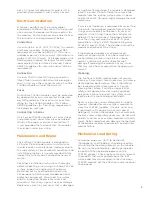
3
• Under normal conditions, a photovoltaic
module is likely to experience conditions
that produce more current and/or voltage
than reported at standard test conditions.
The requirements of the National Electrical
Code (NEC) in Article 690 shall be followed
to address these increased outputs. In
installations not under the requirements of
the NEC, the values of Isc and Voc marked on
this module should be multiplied by a factor
of 1.25 when determining component voltage
ratings, conductor ampacities, overcurrent
device ratings, and size of controls connected
to the PV output.
• A module without a frame (laminate) shall
not be considered to comply with the
requirements of UL 1703 unless the module is
mounted with hardware that has been tested
and evaluated with the module under this
standard or by a field Inspection certifying
that the installed module complies with the
requirements of UL 1703.
• A module with exposed conductive parts
is considered to be in compliance with UL
1703 only when it is electrically grounded in
accordance with the instructions presented
below and the requirements of the National
Electrical Code.
• Installing solar photovoltaic panels and
systems requires specialized skills and
knowledge. Do not attempt to install these
panels if not qualified to do so.
• Installation should only be performed by
qualified persons.
• The installer assumes all risks of injury that
might occur during installation, including but
not limited to, the risk of electric shock.
• Danger!
A single module generates more
than 30V DC when exposed to sunlight and
system voltages can be as high as 1000 V.
Contact with voltages greater than 30V DC
can be hazardous, leading to electric shock
and possibly death.
• Danger!
Even though it is safe to walk on the
FLEX60 modules, it could become dangerous
if the top surface has been damaged,
degrading the dielectric resistance of the
module. This could lead to electric shock.
Have qualified personnel ensure all modules
surfaces are undamaged before walking on
them.
• Danger!
Water exposure can lead to
increased risk of electric shock if the
module’s encapsulation system has been
compromised. Have qualified personnel
ensure there is no leakage current and the
system is in safe working order before walking
on or working on the modules.
• Danger!
The FLEX60 modules may become
slippery when wet. This could cause a slip
hazard. If modules are wet, walk carefully,
and keep your center of gravity. Failure to
do so could result in a fall hazard leading to
personal injury. If working on a roof without
a parapet or other curb type system, fall
protection needs to be deployed.
• Danger!
Do not stand or walk on modules
unless they are clean. Dirt and debris could
damage the outer surface of the module
exposing electrical components leading to
electric shock.
• Danger!
Do not drop objects such as tools
onto the modules. This could damage the
modules encapsulation surfaces exposing
electrical components leading to risk of
electric shock.
• Warning!
Short circuits on the DC side of
the installation can cause arcing. Unlike
arcs occurring in low voltage AC wiring,
these arcs are not self-extinguishing. The
high temperatures generated by these arcs
can destroy connectors. If not handled
and installed according to instructions, PV
modules can present a lethal as well as a fire
hazard.
• Danger!
Damaged modules, cables, and
connectors can present a shock hazard
resulting in electrocution and death. Do not
attempt to install, service, remove, touch
or modify a damaged module. Damaged
modules should only be removed by qualified
professionals wearing appropriate personal
protection equipment for high voltage. If
damaged modules are found, they should
be immediately identified and secured from
access by unauthorized individuals. Never
attempt to remove or otherwise service a
damaged module if it is wet or raining.
• Danger!
To service a module, (1) isolate the
string from others in the system, (2) use
blackout blankets on the entire string to
remove voltage from the system and then (3)
disconnect the target module. You may then
remove the module from the roof keeping the
blackout blanket over the module to prevent
voltages from developing during removal.
Failure to follow these procedures may lead
to electric shock.
• All electrical work must be performed
by qualified personnel only. All electrical
material must be suitable for DC and rated
































